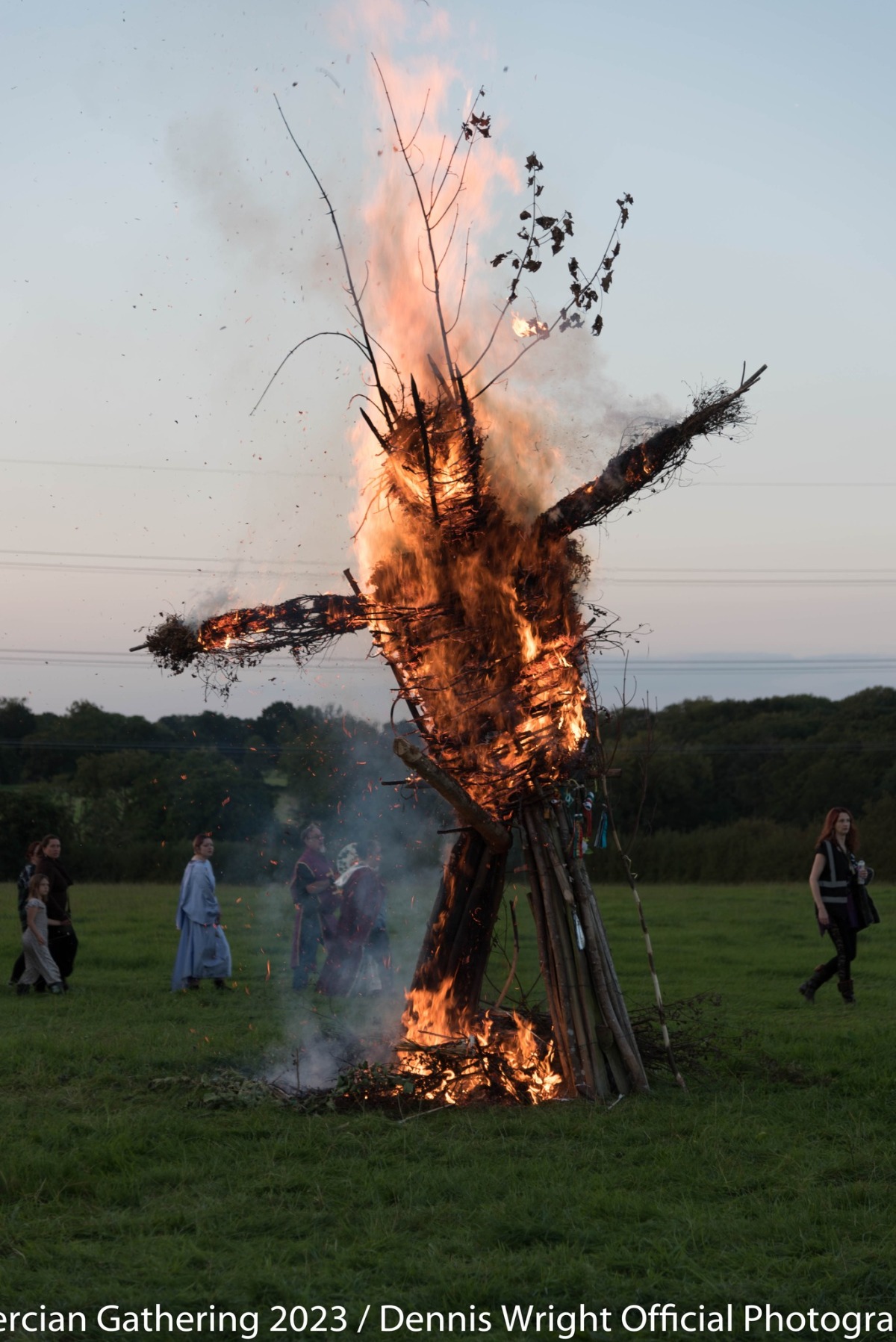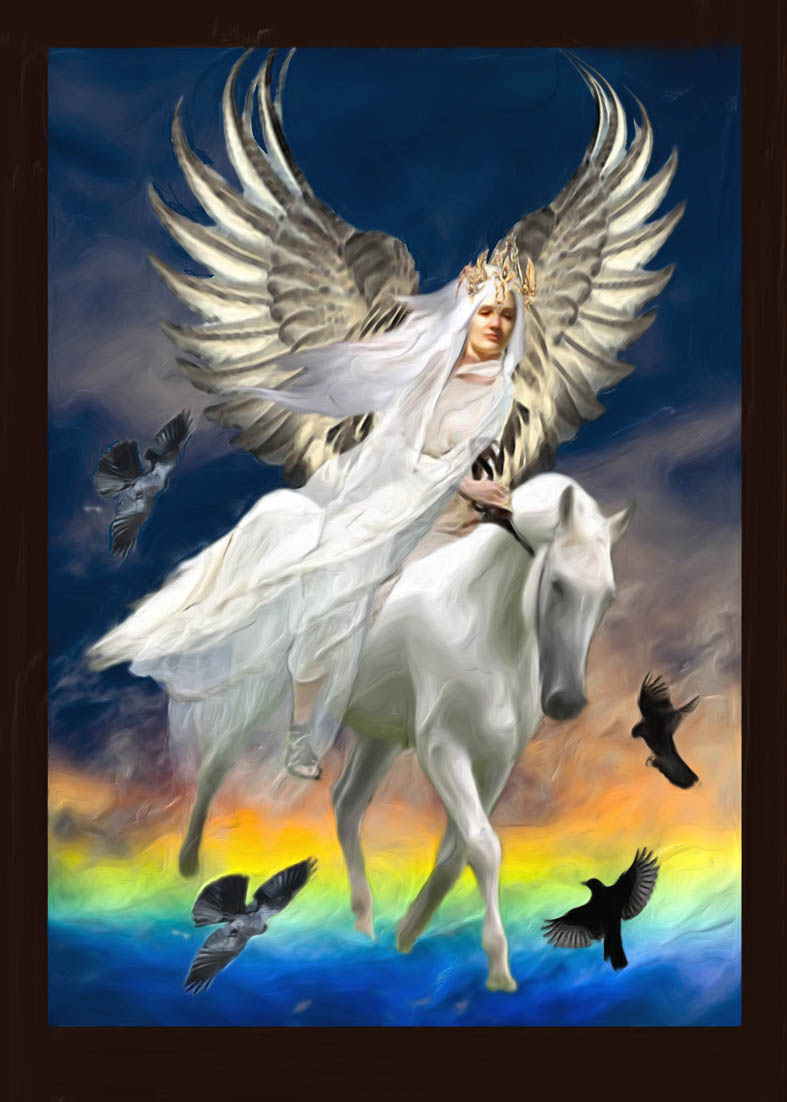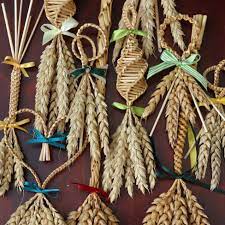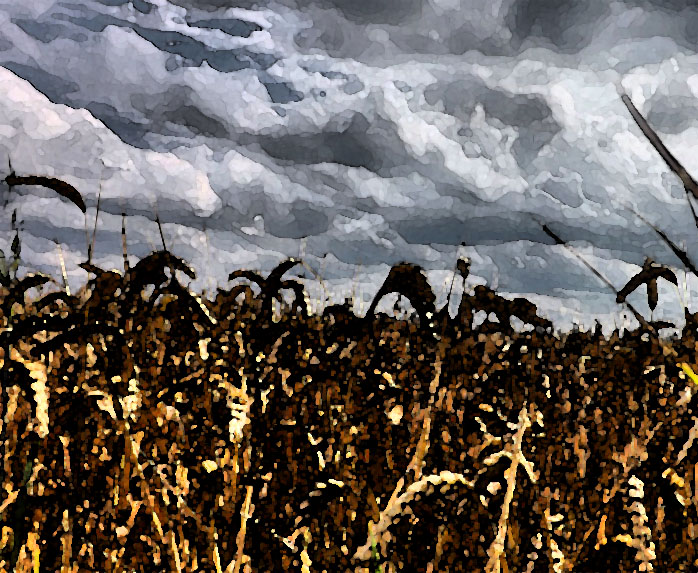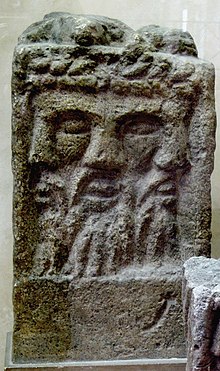Around the world the first of the harvest was offered to the gods:
“In some festivals … the sacrament of the first fruit is combined with a sacrifice or presentation of them to gods or spirits, …The mere fact of offering the first-fruits to the gods or spirits comes now to be thought a sufficient preparation for eating the new corn; the higher powers having received their share, man is free to enjoy the rest.” [1]
After giving the gods their portion, people were free to enjoy the rest.
There seems to have been a general reluctance to eat the First Fruits until some ceremony had been performed because they belonged to – or even contained – a god. The Bororo of Brazil thought it certain death to eat the new maize until it had been blessed by the medicine man. The Aino called millet ‘the divine cereal’ or ‘the cereal god’, and prayed to him before they would eat the new millet. Estonians would not eat bread from the new corn until they had bitten on iron to protect them from the spirit within. In Sutherland, when the new potatoes were dug, the whole family had to taste them or the spirits in them would be offended and the potatoes would not keep. In the nineteenth century it was customary in Yorkshire for a clergyman to cut the first corn, which was made into communion bread. [2] It was often the case that people would have to fast or even purge themselves with emetics before eating the new harvest and coming into contact with the god within it. Christians still fast before taking the Eucharist.
In ancient Greece, barley was offered as First Fruits to the goddesses Demeter and Kore at the great temple of Eleusis, where underground granaries stored the contributions. Theocritus recorded how in Cos ‘in sweet smelling summer’ each farmer offered the First Fruits of his harvest to Demeter, the goddess who had filled his threshing floor with barley, and whose rural image held sheaves and poppies in her hands. In Rome each household offered the First Fruits at meal times.
In Mexico, the First Fruits of the season were offered to the sun while a criminal was crushed between two stones in a sacrifice known as ‘the meeting of the stones’, which presumably imitated the mill stones which would grind the corn. Afterwards everyone feasted and drank.
Several Native American tribes practiced (and some still practice) Green Corn Ceremonies to coincide with the ripening of the crops. It was the central festival of the year and celebrated not only the ripening of the new corn, but the renewal of the annual cycle and the spiritual and social life of the people. Though customs vary from tribe to tribe and area to area, they are generally concerned with a ritual purification before the renewal of the harvest, sometimes with fasting and even purging with button-snake plant (Eryngium Yuccaefolium). Sometimes ritual bloodletting would also take place. Traditionally, everything would be torn down and replaced. The ceremonial and all hearth fires were put out, and all coal and ash cleaned away.
There were many dances, and the ceremonial fire was relit. The Cherokees used a branch of wood from a tree struck by lightning, which was lit and used to bless the grounds for the ceremony and then this ‘thunder-wood’ was used to kindle the sacred fire in the pit in the centre of the circle. Amongst the Creek, the sacred hearth was dug out, and the medicine man made an offering of the button-snake plant, tobacco and some of the First Fruits in the hearth pit, which was then covered up with white clay. (Amongst the Creek, the sacred fire is identified with the sun; both are masculine forces and part of the male ritual domain.) A new fire was lit, and an offering of First Fruits was made to the hearth spirits, and the women carried burning brands from it back to their own hearths to rekindle them.[3]
There were rites of passage for youths about to become men, and displays of war-party tactics and virility. Within the dance circle, the dance leader and priest would make offerings to the Thunder Beings and the ancestor spirits as a gesture of thanks for a fruitful corn harvest. As it was a time of renewal and new beginnings, minor infractions of the religious and clan law, as well as debts were typically forgiven. [4]
Historically, even tribes which did not practice agriculture observed analogous ceremonies. Among the Salish and Tinneh of North-West America, before the young people ate the first berries or roots of the season, they always addressed the fruit or plant and begged for its favour and aid. In some tribes regular First Fruit ceremonies were annually held at the time of picking the wild fruit or gathering the roots, and also among the salmon-eating tribes when the run of the salmon began. [5]
The Thompson tribe of British Columbia cooked and ate the sunflower root (Balsamorrhiza sagittata). When young people ate the first berries, roots or other products of the season, they addressed a prayer to the sunflower root as follows:
“I inform thee that I intend to eat thee. Mayest thou always help me to ascend, so that I may always be able to reach the tops of mountains, and may I never be clumsy! I ask this from thee, Sunflower-Root. Thou art the greatest of all in mystery.” [6]
The ancient Canaanites offered the First Fruits of the crop, fire-dried, to the gods. The Israelites followed this custom and according to the Bible:
“Thou shalt offer for the meat offering of thy First Fruits green ears of corn dried by the fire, even corn beaten out of its full ears.” [7]
In Leviticus we read that Jehovah instructed Moses:
“When you shall have entered the land which I will give you, and shall reap your corn, you shall bring sheaves of wears, the First Fruits of the harvest, to the priest…You shall not eat either bread, or parched corn, or frumenty of the harvest, until that day you shall offer thereof to your God.”
Shavout, the Festival of Weeks – also referred to in the Bible as Hag HaBikkurim (Festival of First Fruits) – is the Jewish festival that commemorates the giving of the Torah to Moses on Mount Sinai. It also celebrates the beginning of the harvest when the First Fruits were bought to the Temple in Jerusalem to be offered to God. It falls around late June or early July, earlier than Lammas, but the crops ripen earlier further south. One sheaf is taken from the standing crops and brought to the priest:
“…and he shall wave the sheaf before the Lord for you to be accepted: on the day after the Sabbath the priest shall wave it.” [8]
It is customary to decorate synagogues and homes with flowers and greenery and eat a celebratory meal comprised of new fruits, vegetables and a dairy dish.
In the Eastern Orthodox Church the offering of First Fruits begins on the Feast of the Transfiguration (August 6th), with the blessing of grapes. In localities where grapes are not grown, other early-ripening fruits such as apples may be offered. In French churches of the Middle Ages, new fruits were at given seasons presented at Mass for blessing. The blessed fruits were kept by the church and divided between the clergy and the poor. Similar customs during the Middle Ages could be found in all European countries.
In Russia Yablochnyi or Medovoy Spas is a cross-quarter holiday between the summer solstice and the autumn equinox. Also known as ‘Apple Honey Saviour’, it celebrates the start of the harvest when fruit and honey are ready to be gathered. The beehives would also be blessed and horses purified by swimming them in rivers. The festival of Zaziuki is celebrated on or about the seventh of August and may have originally been part of the same holiday as the Yablochnyi. The first sheaf of corn, the zazhinochnyl or zazhinnyi, was taken into the farmhouse and threshed separately. In some areas it would be blessed and mixed in with the seed-corn.
The peasants of the Lublin region of Poland gather together a week before the harvest celebration, or Dozynki, to make the przepiorka, a three-dimensional wreath decorated with ribbons and flowers. This wreath is then presented to the owners of the land, known as ‘the revered Lord and Lady’. The Lord oversees the progress of the harvest and is hailed with chants “That he may live and prosper for a hundred years!” A female harvester is then chosen to become the Przodownica (Harvest Queen). She is selected on the basis of a combination of beauty, hard work and eloquence. The Harvest Queen is encircled by the whole of the community and honoured with a crown made of wheat, rye, oats, and wild flowers.
The Dozynki celebration itself is held on or near the Feast of the Assumption, August 15th. The harvesters dress up in their traditional ornately embroidered Sunday clothes and march in a procession to the farmhouse, singing “Plon mamy plon, ze wszystkich stron” (‘we have gathered the harvest for you from all sides of the field’). The Harvest Queen removes her crown of grains and flowers, gives a speech in praise of the workers, and bestows a blessing on the Lord and Lady, offering her crown as a symbolic sacrifice. The fruits of the new harvest are then presented including bread made from the fresh wheat, wine from the new grapes and baskets of fruits and vegetables. The Lord and Lady offer vodka and other drinks to celebrate the occasion, and are thanked for their hospitality and goodwill. The festival continues until the early hours with traditional music, dancing and songs.
The last sheaf (the dozhinochnyi orotzhinnyi) would also be decorated with flowers, ribbons, or women’s clothing and placed in the entrance corner of the home until 1st October, when it would be fed to the cattle. Sometimes this ceremony would be combined with that of a small patch of corn, which was left uncut. The spirit of the harvest was said to hide from the reapers in this uncut patch of wheat, which was known as the ‘Beard of Velos (or Veles)’. Velos was the god of animals and wealth. The uncut sheaves were decorated with ribbons and bent towards the ground in a ritual known as ‘curling the beard’; the harvest spirit was believed to be sent back to the earth to ensure fertility in the following year. Bread and salt, the traditional symbols of hospitality, were left as offerings.
© Anna Franklin, from Lughnasa, History, Lore and Celebration by Anna Franklin & Paul Mason, Lear Books, 2010
[1] James Frazer, The Golden Bough, Macmillan, London, 1976
[2] James Frazer, The Golden Bough, Macmillan, London, 1976
[3] James Frazer, The Golden Bough, Macmillan, London, 1976
[4] http://en.wikipedia.org/wiki/Green_Corn_Ceremony
[5] James Frazer, The Golden Bough, Macmillan, London, 1976
[6] James Frazer, The Golden Bough, Macmillan, London, 1976
[7] Leviticus 2:4
[8] Leviticus 23:9-14

